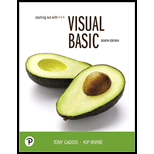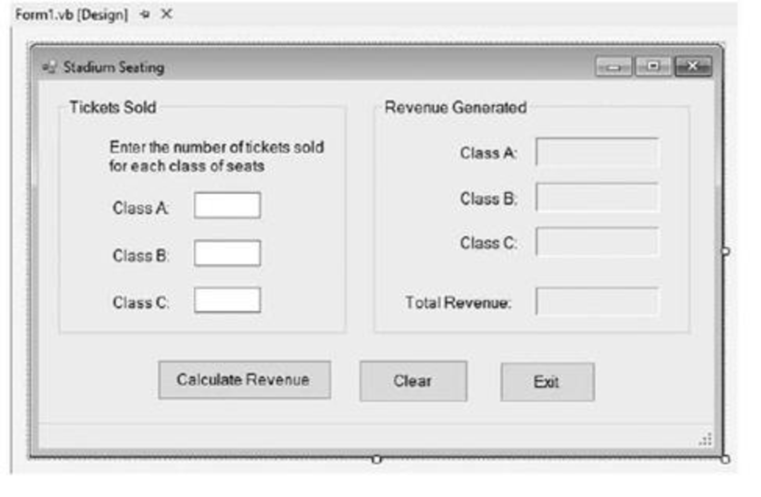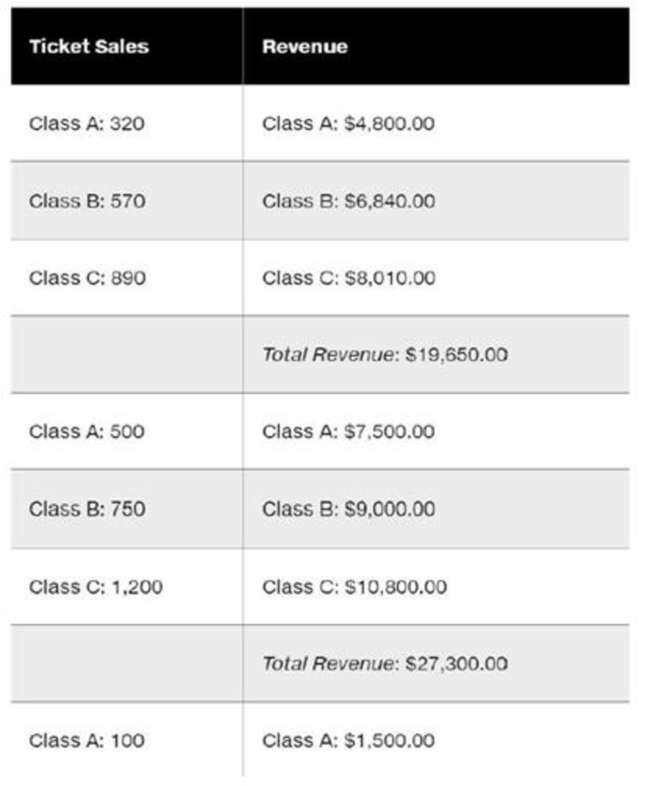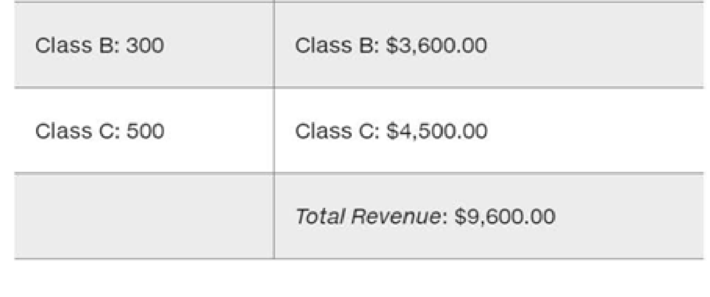
There are three seating categories at a high school athletic stadium. For a baseball game, Class A seats cost $15 each, Class B seats cost $12 each, and Class C seats cost $9 each. Create an application that allows the user to enter the number of tickets sold for each class. The application should be able to display the amount of income generated from each class of ticket sales and the total revenue generated. If the user fails to enter numeric values, display an appropriate error message and do not attempt to perform calculations. The application’s form should resemble the one shown in Figure 3-59.
Figure 3-59 Stadium Seating from in the Designer

Use the following test data to determine if the application is calculating properly:


Want to see the full answer?
Check out a sample textbook solution
Chapter 3 Solutions
Pearson eText for Starting Out With Visual Basic -- Instant Access (Pearson+)
Additional Engineering Textbook Solutions
Management Information Systems: Managing The Digital Firm (16th Edition)
Starting Out with Java: From Control Structures through Objects (7th Edition) (What's New in Computer Science)
Computer Science: An Overview (13th Edition) (What's New in Computer Science)
Java: An Introduction to Problem Solving and Programming (8th Edition)
Thinking Like an Engineer: An Active Learning Approach (4th Edition)
Starting Out with C++ from Control Structures to Objects (9th Edition)
- EX:[AE00]=fa50h number of ones =1111 1010 0101 0000 Physical address=4AE00h=4000h*10h+AE00h Mov ax,4000 Mov ds,ax; DS=4000h mov ds,4000 X Mov ax,[AE00] ; ax=[ae00]=FA50h Mov cx,10; 16 bit in decimal Mov bl,0 *: Ror ax,1 Jnc ** Inc bl **:Dec cx Jnz * ;LSB⇒CF Cf=1 ; it jump when CF=0, will not jump when CF=1 HW1: rewrite the above example use another wayarrow_forwardEX2: Write a piece of assembly code that can count the number of ones in word stored at 4AE00harrow_forwardWrite a program that simulates a Magic 8 Ball, which is a fortune-telling toy that displays a random response to a yes or no question. In the student sample programs for this book, you will find a text file named 8_ball_responses.txt. The file contains 12 responses, such as “I don’t think so”, “Yes, of course!”, “I’m not sure”, and so forth. The program should read the responses from the file into a list. It should prompt the user to ask a question, then display one of the responses, randomly selected from the list. The program should repeat until the user is ready to quit. Contents of 8_ball_responses.txt: Yes, of course! Without a doubt, yes. You can count on it. For sure! Ask me later. I'm not sure. I can't tell you right now. I'll tell you after my nap. No way! I don't think so. Without a doubt, no. The answer is clearly NO. (You can access the Computer Science Portal at www.pearsonhighered.com/gaddis.)arrow_forward
 Microsoft Visual C#Computer ScienceISBN:9781337102100Author:Joyce, Farrell.Publisher:Cengage Learning,
Microsoft Visual C#Computer ScienceISBN:9781337102100Author:Joyce, Farrell.Publisher:Cengage Learning, Programming with Microsoft Visual Basic 2017Computer ScienceISBN:9781337102124Author:Diane ZakPublisher:Cengage Learning
Programming with Microsoft Visual Basic 2017Computer ScienceISBN:9781337102124Author:Diane ZakPublisher:Cengage Learning EBK JAVA PROGRAMMINGComputer ScienceISBN:9781337671385Author:FARRELLPublisher:CENGAGE LEARNING - CONSIGNMENT
EBK JAVA PROGRAMMINGComputer ScienceISBN:9781337671385Author:FARRELLPublisher:CENGAGE LEARNING - CONSIGNMENT- Programming Logic & Design ComprehensiveComputer ScienceISBN:9781337669405Author:FARRELLPublisher:CengageNp Ms Office 365/Excel 2016 I NtermedComputer ScienceISBN:9781337508841Author:CareyPublisher:Cengage




